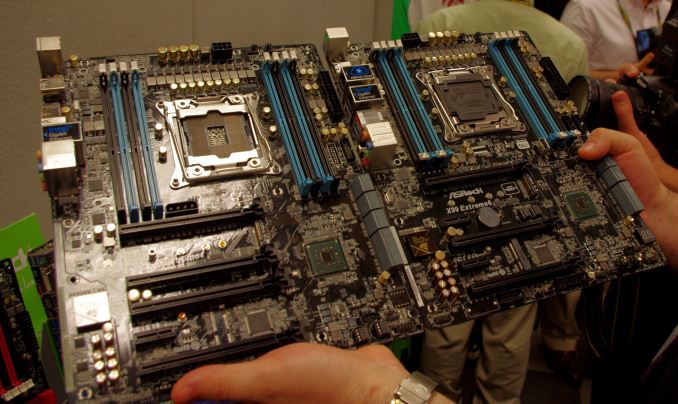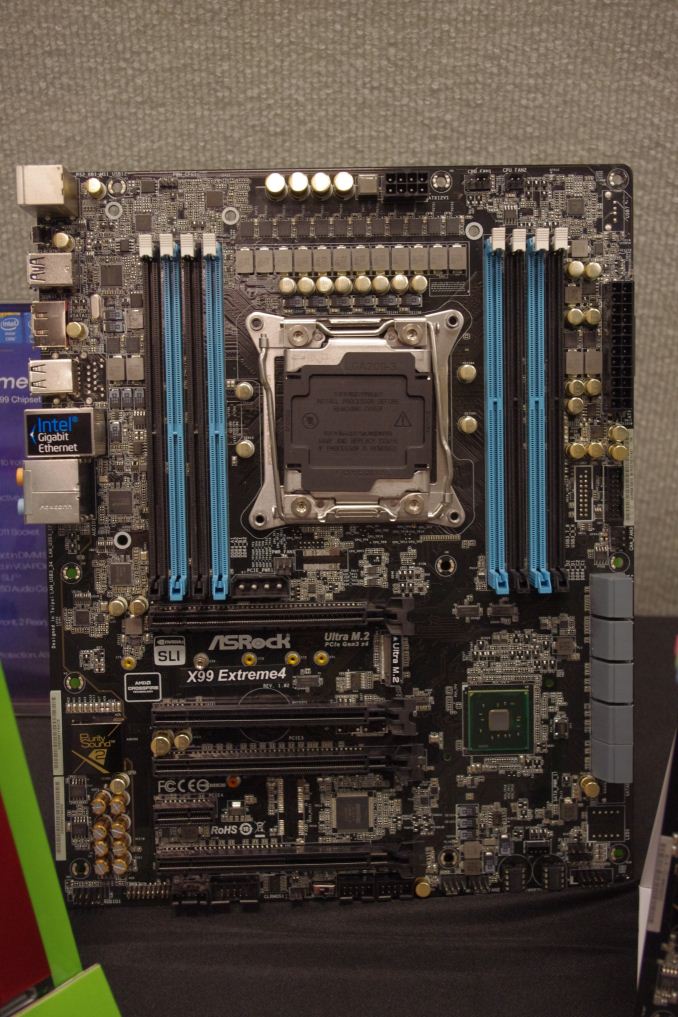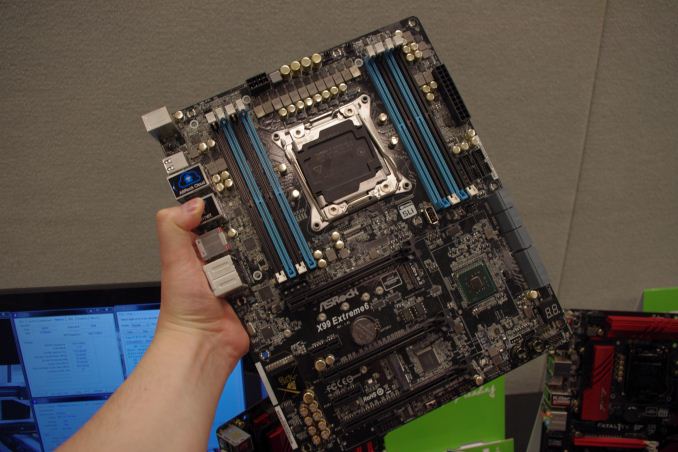Computex 2014: X99 on Display from ASRock
by Ian Cutress on June 4, 2014 9:29 PM EST- Posted in
- Motherboards
- Intel
- ASRock
- X99
- Computex 2014

ASRock hosted a VIP media function at Computex yesterday and we were lucky enough to get front row seats. The main talking point of the day was the new 9-series motherboards, including a couple of new models aimed at the cheaper end of the overclocking market due to the release of Intel’s Pentium Anniversary Edition (an Intel spokesman at the event called it Pentium-AE, which I guess puts an official easy name into the zeitgeist). The more interesting element of ASRock’s display was a pair of X99 motherboards on show, the Extreme4 and Extreme6.
These boards, I was told, are near final production units. In fact they had a PVT model running DDR4 on the show floor, but not at their booth, so we will have to keep an eye out for that. From looking at these motherboards, storage is now fully SATA 6 Gbps, USB 3.0 is now native and we still have 40 lanes of PCIe 3.0.
The new socket is definitely LGA2011-3, with a slightly new protective plate over the socket. We have quad channel memory, with X99 at two DIMMs per channel. I have seen some other LGA2011-3 mockups elsewhere on the show floor (which I can’t write about, unfortunately), with three DIMMs per channel, although this might be restricted to server motherboards.
I eagerly await X99 and Haswell-E, especially with the wealth of DDR4 on display this year.



















16 Comments
View All Comments
Morawka - Wednesday, June 4, 2014 - link
Socket is massivedylan522p - Thursday, June 5, 2014 - link
Sadly the die will only be massive for exons. Extreme editions dies will remain fairly small.dragonsqrrl - Thursday, June 5, 2014 - link
3 DIMMs per channel?? Will the i7's support that?Ian Cutress - Thursday, June 5, 2014 - link
At this point, no info is made public. But I would assume that the i7s will be limited to two DIMMs per channel. Although I wonder if the workstation motherboards, with the consumer angle that support Xeons, will stick to two per channel.MrSpadge - Thursday, June 5, 2014 - link
Wasn't DDR4 supposed to be liimiited to 1 DIMM per channel? Well, it's obviously not.. but I remember reading this even on AT.Homeles - Thursday, June 5, 2014 - link
I've found no mention of how channels are supposed to be handled in JEDEC's guidelines on DDR4. It appears that that manufacturers are free to do what they want. Signal noise does worsen as you add DIMMs to the channel, and it's likely that as speeds increase, they'll have to stick to 1 DPC (DIMMs Per Channel).However, even if DDR4 is Point-to-Point, the DPC limit can be worked around with the use of a digital switch.
And yes, AnandTech has reported in the past that DDR4 would be limited to 1 DPC. It's plastered almost practically everywhere, including presentations from universities, but such information is missing from the only places that matter, like Micron, JEDEC, Samsung, Hynix, et al.
Laststop311 - Monday, June 9, 2014 - link
ddr4 is not going to be limited to only 4 slots there will be 8 slots just like on all other x79 chipsets. And 16GB standard non ecc dimms should become available then too. Allowing up the 128GB of ram on consumer machines.Laststop311 - Monday, June 9, 2014 - link
OoOOOO 128GB of ram. Just imagine the huge 100GB ram discs you could make and do all your work directly off the ram stick and only use the HDD to periodcly save ur work. SUCH SPEED 3000 MHZ quad channel ddr4 with all your accesses coming from that instead of storage. Sick speedEngA1 - Tuesday, June 24, 2014 - link
Not so fast...I highly suspect in the consumer based Intel processor product line, there will be a continued limitation on physical addressing. For example, current LGA 1150 have addressing limitations of 32GB, conversely - the current LGA2011 have addressing limitations imposed by Intel at 64GB. IF you desire something larger - you enter the Xeon domain. Calling up Intel.com Web site and punching in a processor i3, i5 or i7 will illustrate "Max Memory Size (dependent on memory type)." With the "?" revealed in your mouse pointer - click to note their definition of what that statement means. Now, call up a corresponding Xeon processor - see what it's "limitations" are on addressable memory size. Welcome to Intel Marketing limitations in the designs in full swing! It's all based on restrictions based on how much you want to pay.
dragonsqrrl - Monday, July 21, 2014 - link
Sorry, but that's not the way it works, at all...Jeez, not even sure where to start. The density limitations you're referring to are a result of memory standards and RAM specifications, they aren't artificial "addressable memory" limitations imposed by Intel. The only way to achieve the densities you're talking about is by using FBDIMMs, which are different from your normal DDR3 and aren't supported on consumer platforms for various reasons including cost, demand, and performance. Basically it doesn't make a whole lot of sense to bring consumer support when the primary benefits are far more pronounced in server/enterprise environments and the primary weaknesses are more pronounced in consumer environments.